

The History of Christmas
 The
Birth of Christ
The
Birth of ChristKing August, who ruled Palestine, wanted to know the number of people in his kingdom. For that reason, he requested the names of all the people and everyone had to return to the birthplace of his ancestors. The Most Blessed Virgin Mary and Joseph were of the family of David; therefore, they journeyed to Bethlehem, the birthplace of David.
Exhausted from the long journey, they arrived in Bethlehem at night. There was no available place to sleep at the Inns or at any of the homes as a great number of people had gone there at King's request. Having no place to sleep, Mary and Joseph went to the outskirts of Bethlehem and there found a stable where the shepherds of Bethlehem kept their cattle during stormy weather. It was here that they planned to spend the night. Around midnight, the stars in the heavens lit up the stable and the Most Blessed Virgin Mary gave birth to a male child. She wrapped him in swaddling clothes and laid him in the straw in the manger. The little town of Bethlehem slept peacefully, unaware of the blessed event that had taken place.
 The
first to hear of the birth of Christ were the shepherds of Bethlehem who
were watching their sheep. An angel from heaven brought them the joyous
tidings and told them to go to the town of Bethlehem where they would find
the babe in a straw-filled manger. The heavens shone with a heavenly light
and angles began to sing: "Glory to God in the Highest, and on earth , Peace
and Good will toward Men." The shepherds hastened to the stable where they
truly found Lord Jesus Christ as a babe in swaddling clothes laying in a
manger of straw. They worshiped the new-born Savior, and related to the
righteous Joseph and the Most Holy Mother of God what they had seen and
heard from the angels in the heavens. The shepherds then left, overjoyed,
glorifying and praising God.
The
first to hear of the birth of Christ were the shepherds of Bethlehem who
were watching their sheep. An angel from heaven brought them the joyous
tidings and told them to go to the town of Bethlehem where they would find
the babe in a straw-filled manger. The heavens shone with a heavenly light
and angles began to sing: "Glory to God in the Highest, and on earth , Peace
and Good will toward Men." The shepherds hastened to the stable where they
truly found Lord Jesus Christ as a babe in swaddling clothes laying in a
manger of straw. They worshiped the new-born Savior, and related to the
righteous Joseph and the Most Holy Mother of God what they had seen and
heard from the angels in the heavens. The shepherds then left, overjoyed,
glorifying and praising God.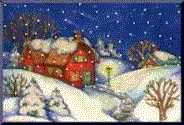 When
the Lord Jesus Christ was born, there appeared in the Far East an unusually
bright star. Seeing this star, three wise men knew that the promised Savior
of the world had been born, whom they were anxiously awaiting, so they
started out to find him. The star in the heavens showed them the way to
Bethlehem, then they came to the stable where Jesus lay in the manger. The
wise men entered, and saw the child with his mother, and fell on their
knees. Gifts of gold, frankincense and myrrh were laid at his feet. And the
angels sang....
When
the Lord Jesus Christ was born, there appeared in the Far East an unusually
bright star. Seeing this star, three wise men knew that the promised Savior
of the world had been born, whom they were anxiously awaiting, so they
started out to find him. The star in the heavens showed them the way to
Bethlehem, then they came to the stable where Jesus lay in the manger. The
wise men entered, and saw the child with his mother, and fell on their
knees. Gifts of gold, frankincense and myrrh were laid at his feet. And the
angels sang.... The
Christmas Tree Legends
The
Christmas Tree Legends
The custom of a Christmas tree, undecorated, is believed to have begun in
Germany, in the first half of the 700s.
The earliest story relates how British monk and missionary St. Boniface was
preaching a sermon on the Nativity to a tribe of Germanic Druids outside the
town of Geismar. To convince the idolaters that the oak tree was not sacred
and inviolable, the "Apostle of Germany" felled one on the spot. Toppling,
it crushed every shrub in its path except for a small fir sapling. A chance
event can lend itself to numerous interpretations, and legend has it that
Boniface, attempting to win converts, interpreted the fir's survival as a
miracle, concluding, "Let this be called the tree of the Christ Child."
Subsequent Christmases in Germany were celebrated by planting fir saplings.
 The
history of the modern Christmas tree goes back to 16th century Germany. In
Alsace (Elsass), dated 1561, states that "no burgher shall have for
Christmas more than one bush of more than eight shoes' length." The
decorations hung on a tree in that time, the earliest we have evidence of,
were "roses cut of many-colored paper, apples, wafers, gilt, sugar." Around
Strasbourg there was a widespread practice of bringing trees (evergreens,
not necessarily a fir-tree) into houses for decoration during Christmastide.
The
history of the modern Christmas tree goes back to 16th century Germany. In
Alsace (Elsass), dated 1561, states that "no burgher shall have for
Christmas more than one bush of more than eight shoes' length." The
decorations hung on a tree in that time, the earliest we have evidence of,
were "roses cut of many-colored paper, apples, wafers, gilt, sugar." Around
Strasbourg there was a widespread practice of bringing trees (evergreens,
not necessarily a fir-tree) into houses for decoration during Christmastide.
The modern custom is also connected with the Paradise tree hung with apples,
present in the medieval religious plays. The decorations could symbolize the
Christian Hosts. Instead of trees, various wooden pyramidal structures were
also used. In 17th century the Christmas tree spread through Germany and
Scandinavia. Eventually the tree was extensively decorated, first with
candles and candies, then with apples and confections, later with anything
glittering mass-produced paraphernalia.
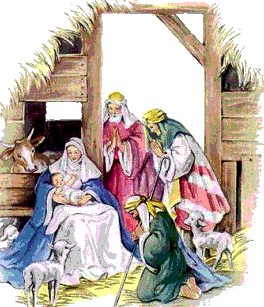
The success of Christmas
tree in Protestant countries was enhanced by the legend which attributed the
tradition to Martin Luther himself. It is a widely held belief that Martin
Luther first added lighted candles to a tree. Walking toward his home one
winter evening, composing a sermon, he was awed by the brilliance of stars
twinkling amidst evergreens. To recapture the scene for his family, he
erected a tree in the main room and wired its branches with lighted candles.
In England the tradition was made popular by the German Prince Albert,
husband of Queen Victoria. The German immigrants brought the Christmas tree
to America in 17th century. Public outdoors Christmas trees with electric
candles were introduced in Finland in 1906, and in USA (New York) in 1912.
The claim of the Pennsylvania Germans to have initiated the Christmas tree
custom in America is undisputed today. And it's in the diary of Matthew Zahm
of Lancaster, Pennsylvania, under the date December 20, 1821, that the
Christmas tree and its myriad decorations received their first mention in
the New World.
It is no surprising that, like many other festive Christmas customs, the
tree was adopted so late in America. To the New England Puritans, Christmas
was sacred. The Pilgrims' second governor, William Bradford, wrote that he
tried hard to stamp out "pagan mockery" of the observance, penalizing any
frivolity. The influential Oliver Cromwell preached against "the heathen
traditions" of Christmas carols, decorated trees and any joyful expression
that desecrated "that sacred event."
 The
Plantings
The
Plantings
Santa delivers presents under the "Christmas Trees" every year for all the
children around the world. Because not everyone lives near a place that they
can go and cut down their own Christmas tree, Santa arrange for a commercial
Christmas tree farming to begin in back in 1901 to help him by growing
trees, cutting them down and selling them to people for Christmas.
This planting tradition has caught on and sometimes people will buy live
trees for Christmas, decorate them and then after Christmas they replant
them in their yards or around their homes. This then not only makes the
yards and landscape around their house look nice, but it also save the
trees.
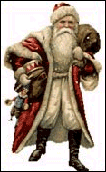 "The"
Santa Claus
"The"
Santa Claus
The original Santa Claus, St. Nicholas, was born in the ancient southeastern
Turkish town of Lycia early in the fourth century. His generosity was
legend, and he was particularly fond of children. We know this primarily
through Roman accounts of his patronage of youth, which eventually led to
his becoming the patron saint of children. Throughout the Middle Ages, and
well beyond, he was referred to by many names none of them Santa Claus.
Children today would not at all recognize the St. Nick who brought gifts to
European children hundreds of years ago except perhaps for his cascading
white beard. He made his rounds in full red-and-white bishop's robes,
complete with twin-peaked miter and crooked crozier. He was pulled by no
fleet-footed reindeer, but coaxed in indolent donkey. And he arrived not
late on Christmas Eve, but on his Christian feast day, December 6. The gifts
he left beside the hearth were usually small: fruit, nuts, hard candies,
wood and clay figurines.
During the Protestant of the sixteenth century, St. Nicholas was banished
from most European countries. Replacing him were more secular figures, who
in general were not at center stage at that point in history.
The Dutch kept the St. Nicholas tradition alive. As the "protector of
sailors," St. Nicholas graced the prow of the first Dutch ship that arrived
in America. And the first church built in New York City was named after him.
The Dutch brought with them to the New World two Christmas items that were
quickly Americanized.

In sixteenth-century
Holland, children placed wooden shoes by the hearth the night of St.
Nicholas's arrival. The shoes were filled with straw, a meal for the saint's
gift-laden donkey. In return, Nicholas would insert a small treat into each
clog. In America, the shoe was replaced with the stocking, hung by the
chimney.
Sint Nikolaas's helper, Zwarte Piet (Black Pete) who on the night before Dec
6, would go around town opening doors and throwing handfulls of candy into
the rooms. Also in Holland, Sint Nikolaas would arrive on a ship riding a
large white horse.
The Dutch spelled St. Nicholas "Sint Nikolass," which in the New World
became "Sinterklass". later changed to "Santa Claus".
Much of modern-day Santa Claus lore, including the reindeer-drawn sleigh,
originated in America. Dr. Clement Clarke Moore composed "The Night Before
Christmas" in 1822, to read to his children on Christmas Eve. The poem might
have remained privately in the Moore family if a friend had not mailed a
copy of it (without authorial attribution) to a newspaper and became part of
the Santa legend.
 It
was in America that Santa put on weight. The rosy-cheeked, roly-poly Santa
is credited to the influential nineteenth-century cartoonist Thomas Nast.
From 1863 until 1886, Nast created a series of Christmas drawings for
Harper's Weekly. These drawings, executed over twenty years, exhibit a
gradual evolution in Santa from the pudgy, diminutive, elf-like creature of
Dr. Moore's immortal poem to the bearded, potbellied, life-size bell ringer
familiar on street corners across America today. Nast's cartoons also showed
the world how Santa spent his entire year constructing toys, checking on
children's behavior, reading their requests for special gifts. His images
were incorporated into the Santa lore.
It
was in America that Santa put on weight. The rosy-cheeked, roly-poly Santa
is credited to the influential nineteenth-century cartoonist Thomas Nast.
From 1863 until 1886, Nast created a series of Christmas drawings for
Harper's Weekly. These drawings, executed over twenty years, exhibit a
gradual evolution in Santa from the pudgy, diminutive, elf-like creature of
Dr. Moore's immortal poem to the bearded, potbellied, life-size bell ringer
familiar on street corners across America today. Nast's cartoons also showed
the world how Santa spent his entire year constructing toys, checking on
children's behavior, reading their requests for special gifts. His images
were incorporated into the Santa lore.
Santa is known throughout the world in many different names, such as:
Saint Nikolaas (Sinter Klaas), from the Dutch Father Christmas, from the
English Kris Kringle, Christkind from the Germans , Befana from the
Italians, Bobouschka, from the Russians (a grand motherly figure instead of
a male)
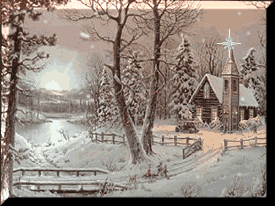
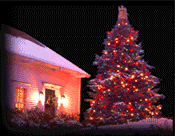 World
Traditions
World
TraditionsChristmas as we know it today is a Victorian invention of the 1860s. Probably the most celebrated holiday in the world, our modern Christmas is a product of hundreds of years of both secular and religious traditions from around the globe.
Sweden
Most people in Scandinavian countries honor St. Lucia (also known as St.
Lucy) each year on December 13. The celebration of St. Lucia Day began in
Sweden, but had spread to Denmark and Finland by the mid-19th century. In
these countries, the holiday is considered the beginning of the Christmas
season and, as such, is sometimes referred to as "little Yule."
Traditionally, the oldest daughter in each family rises early and wakes each
of her family members, dressed in a long, white gown with a red sash, and
wearing a crown made of twigs with nine lighted candles. For the day, she is
called "Lussi" or "Lussibruden (Lucy bride)." The family then eats breakfast
in a room lighted with candles.
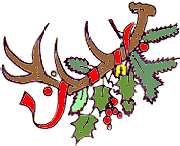 Any
shooting or fishing done on St. Lucia Day was done by torchlight, and people
brightly illuminated their homes. At night, men, women, and children would
carry torches in a parade. The night would end when everyone threw their
torches onto a large pile of straw, creating a huge bonfire. In Finland
today, one girl is chosen to serve as the national Lucia and she is honored
in a parade in which she is surrounded by torchbearers.
Any
shooting or fishing done on St. Lucia Day was done by torchlight, and people
brightly illuminated their homes. At night, men, women, and children would
carry torches in a parade. The night would end when everyone threw their
torches onto a large pile of straw, creating a huge bonfire. In Finland
today, one girl is chosen to serve as the national Lucia and she is honored
in a parade in which she is surrounded by torchbearers.
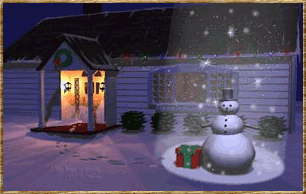
Light is a main theme of St. Lucia Day, as her name, which is derived from the Latin word lux, means light. Her feast day is celebrated near the shortest day of the year, when the sun's light again begins to strengthen. Lucia lived in Syracuse during the fourth century when persecution of Christians was common. Unfortunately, most of her story has been lost over the years. According to one common legend, Lucia lost her eyes while being tortured by a Diocletian for her Christian beliefs. Others say she may have plucked her own eyes out to protest the poor treatment of Christians. Lucia is the patron saint of the blind.
 Finland
Finland
Many Finns visit the sauna on Christmas Eve. Families gather and listen to
the national "Peace of Christmas" radio broadcast. It is customary to visit
the gravesites of departed family members.
Norway
Norway is the birthplace of the Yule log. The ancient Norse used the Yule
log in their celebration of the return of the sun at winter solstice. "Yule"
came from the Norse word hweol, meaning wheel. The Norse believed that the
sun was a great wheel of fire that rolled towards and then away from the
earth. Ever wonder why the family fireplace is such a central part of the
typical Christmas scene? This tradition dates back to the Norse Yule log. It
is probably also responsible for the popularity of log-shaped cheese, cakes,
and desserts during the holidays.
Jamestown,
Virginia
According to reports by Captain John Smith, the first eggnog made in the
United States was consumed in his 1607 Jamestown settlement. Nog comes from
the word grog, which refers to any drink made with rum.
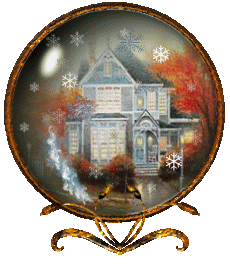
Germany
Decorating evergreen trees had always been a part of the German winter
solstice tradition. The first "Christmas trees" explicitly decorated and
named after the Christian holiday, appeared in Strasbourg, in Alsace in the
beginning of the 17th century. After 1750, Christmas trees began showing up
in other parts of Germany, and even more so after 1771, when Johann Wolfgang
von Goethe visited Strasbourg and promptly included a Christmas tree is his
novel, The Suffering of Young Werther. In the 1820s, the first German
immigrants decorated Christmas trees in Pennsylvania. After Germany's Prince
Albert married Queen Victoria, he introduced the Christmas tree tradition to
England. In 1848, the first American newspaper carried a picture of a
Christmas tree and the custom spread to nearly every home in just a few
years.
 Mexico
Mexico
In 1828, the American minister to Mexico, Joel R. Poinsett, brought a
red-and-green plant from Mexico to America. As its coloring seemed perfect
for the new holiday, the plants, which were called poinsettias after
Poinsett, began appearing in greenhouses as early as 1830. In 1870, New York
stores began to sell them at Christmas. By 1900, they were a universal
symbol of the holiday.
In Mexico, paper mache sculptures called pinatas are filled with candy and
coins and hung from the ceiling. Children then take turns hitting the pinata
until it breaks, sending a shower of treats to the floor. Children race to
gather as much of of the loot as they can.
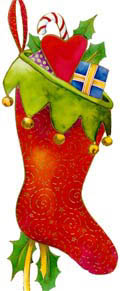 England
England
An Englishman named John Calcott Horsley helped to popularize the tradition
of sending Christmas greeting cards when he began producing small cards
featuring festive scenes and a pre-written holiday greeting in the late
1830s. Newly efficient post offices in England and the United States made
the cards nearly overnight sensations. At about the same time, similar cards
were being made by R.H. Pease, the first American card maker, in Albany, New
York, and Louis Prang, a German who immigrated to America in 1850.
Celtic and Teutonic peoples had long considered mistletoe to have magic
powers. It was said to have the ability to heal wounds and increase
fertility. Celts hung mistletoe in their homes in order to bring themselves
good luck and ward off evil spirits. During holidays in the Victorian era,
the English would hang sprigs of mistletoe from ceilings and in doorways. If
someone was found standing under the mistletoe, they would be kissed by
someone else in the room, behavior not usually demonstrated in Victorian
society.
Plum pudding is an English dish dating back to the Middle Ages. Suet, flour, sugar, raisins, nuts, and spices are tied loosely in cloth and boiled until the ingredients are "plum," meaning they have enlarged enough to fill the cloth. It is then unwrapped, sliced like cake, and topped with cream.
 Caroling
also began in England. Wandering musicians would travel from town to town
visiting castles and homes of the rich. In return for their performance, the
musicians hoped to receive a hot meal or money.
Caroling
also began in England. Wandering musicians would travel from town to town
visiting castles and homes of the rich. In return for their performance, the
musicians hoped to receive a hot meal or money.
In the United States and England, children hang stockings on their bedpost or near a fireplace on Christmas Eve, hoping that it will be filled with treats while they sleep. In Scandinavia, similar-minded children leave their shoes on the hearth. This tradition can be traced to legends about Saint Nicholas. One legend tells of three poor sisters who could not marry because they had no money for a dowry. To save them from being sold by their father, St. Nick left each of the three sisters gifts of gold coins. One went down the chimney and landed in a pair of shoes that had been left on the hearth. Another went into a window and into a pair of stockings left hanging by the fire to dry.
 France
France
In France, Christmas is called Noel. This comes from the French phrase les
bonnes nouvelles," which means "the good news" and refers to the gospel.
In southern France, some people burn a log in their homes from Christmas Eve
until New Year's Day. This stems from an ancient tradition in which farmers
would use part of the log to ensure good luck for the next year's harvest.
Italy
Italians call Chrismas Il Natale, meaning "the birthday."

Australia
In Australia, the holiday comes in the middle of summer--it's not unusual
for some parts of Australia to hit 100 degrees Farenheit on Christmas day.
In Sydney, thousands of families prepare their Christmas dinner and take it
to Bondi Beach for a picnic. Australians decorate with Christmas Bushes,
plants with little red-flowered leaves that are native to Australia.
Ukraine
Ukrainians prepare a traditional twelve-course meal. A family's youngest
child watches through the window for the evening star to appear, a signal
that the feast can begin.
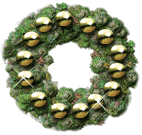 Canada
Canada
Most Canadian Christmas traditions are very similar to those practiced in
the United States. In the far north of the country, the Eskimos celebrate a
winter festival called sinck tuck, which features parties with dancing and
the exchanging of gifts.
Greece
In Greece, many people believe in kallikantzeri, goblins that appear to
cause mischief during the 12 days of Christmas. Gifts are usually exchanged
on January 1, St. Basil's Day.
 Central
America
Central
America
A manger scene is the primary decoration in most southern European, Central
American, and South American nations. St. Francis of Assisi created the
first living nativity in 1224 to help explain the birth of Jesus to his
followers.

![]()
Currently playing:
Sleigh Ride
Music On/Off

